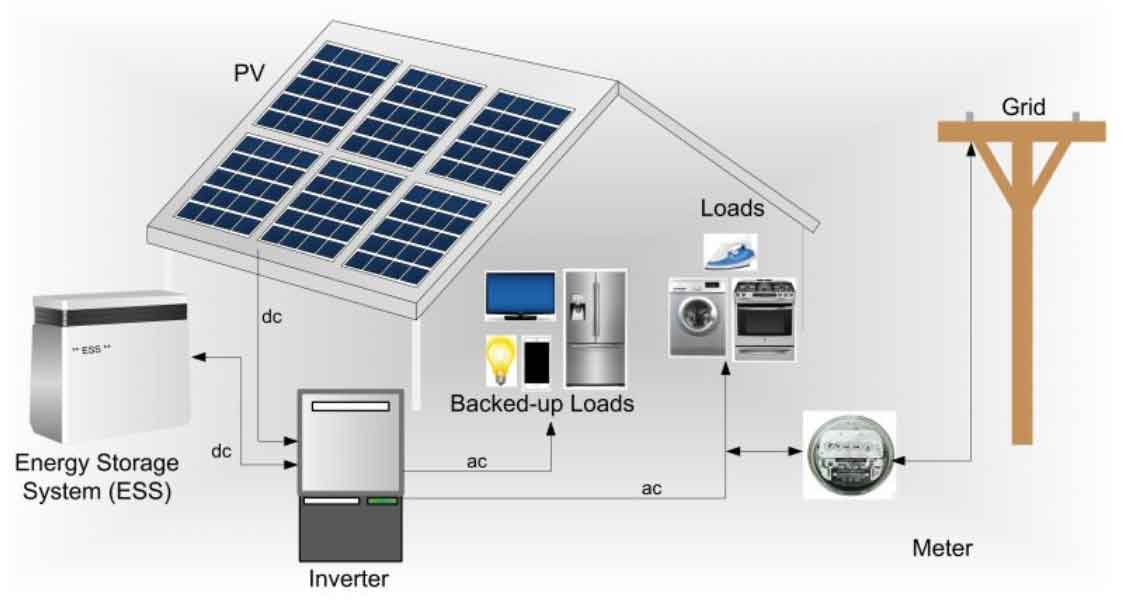In home energy storage systems, such as those used in conjunction with solar panels or for backup power, the terms “low voltage” and “high voltage” refer to the electrical potential difference at which the system operates. Here’s a breakdown of the differences:

1. Voltage Levels
- Low Voltage: Typically defined as up to 48 volts direct current (DC). Some systems might extend this definition slightly above 48 volts, but it generally falls within a range that is considered safer for handling and less stringent in terms of installation regulations.
- High Voltage: Often starts from around 200 volts DC and can go much higher, sometimes up to 800 volts or more. High voltage systems are more common in larger installations or in systems where efficiency in power transmission over distances is critical.
2. Efficiency and Cable Thickness
- Efficiency: High voltage systems are more efficient over long distances. The higher voltage reduces the current for the same amount of power, which decreases home energy storage system lost as heat in the cables. This is particularly advantageous in larger installations where the battery storage might be physically distant from the point of use or home energy storage system generation.
- Cable Thickness: Because high voltage systems carry lower current, they can use thinner and less expensive wiring compared to low voltage systems, which need thicker cables to handle higher currents without overheating.
3. Safety and Installation Complexity
- Safety: Low voltage systems are generally safer and pose less risk of severe electrical shock, making them more suitable for DIY installations. Regulations for low voltage installations are usually less stringent, which can reduce the overall cost and complexity of installation.
- Installation Complexity: High voltage systems typically require specialized knowledge and equipment for safe installation. They must adhere to stricter safety standards and regulations, often requiring professional installation and maintenance.
4. Cost and System Scale
- Cost: The cost of high voltage systems can be higher due not only to the need for professional installation but also due to the more complex inverter and management technology required to handle higher voltages.
- System Scale: High voltage systems are generally better suited to larger scale operations that need to store and use more home energy storage system, whereas low voltage systems are often adequate for typical residential home energy storage system needs.
5. Applications
- Low Voltage Applications: Ideal for smaller residential or off-grid systems where the distance between home energy storage system generation source (like solar panels), the storage system, and the consumption points are relatively short.
- High Voltage Applications: More common in commercial settings or in residential setups that involve larger home energy storage system capacities, possibly due to higher energy consumption or more extensive solar installations.
6. Compatibility with Solar Panels
- Solar Panel Configuration: The voltage of the solar panel array and the home energy storage system should be compatible. Low voltage systems are typically easier to match with standard residential solar panel setups, which usually operate at similar voltage levels. High voltage systems may require specific types of solar panels or additional converters to step up the voltage from the solar array.
7. Battery Technology
- Battery Types: Different types of batteries might have inherent characteristics that make them more suitable for either low or high voltage setups. For instance, lithium-ion batteries are versatile and can be configured for both low and high voltage systems, but the specific arrangement and management systems will differ significantly.
- Management and Safety Features: High voltage batteries often require more sophisticated management systems to monitor and balance the cells, manage temperature, and ensure safe operation. These systems are critical to prevent overcharging, deep discharging, and other conditions that could lead to battery damage or safety risks.
8. Regulatory and Code Compliance
- Installation Codes: Electrical codes and standards might differ significantly between low and high voltage systems. High voltage installations typically face more stringent regulations, including requirements for conduit, distancing, and secure enclosures.
- Permits and Inspections: High voltage systems are more likely to require permits and regular inspections to ensure ongoing compliance with safety standards. This can increase the initial setup time and cost.
9. Resale Value and Insurance
- Resale Value: Investments in high voltage systems might improve the resale value of a home by demonstrating a capacity for high-efficiency energy management and reduced operational costs, particularly in larger homes.
- Insurance Considerations: Some insurers might have different policies regarding the installation of high voltage systems due to perceived risks. It’s important for homeowners to check how either system would affect their insurance premiums and coverage.
10. Future Scalability
- Scalability: High voltage systems are generally more scalable. They can handle increased loads more easily without significant changes to the infrastructure. For homeowners planning future expansion of home energy storage system or anticipating greater energy needs, a high voltage system might offer more flexibility.
Decision Making
Choosing between a low and high voltage home energy storage system depends largely on specific needs, including safety, cost, efficiency, regulatory considerations, and future scalability. Homeowners should consider these factors in the context of their current and anticipated needs to make the most informed decision. Consulting with a professional who can assess the specific conditions and requirements of the home can also provide valuable insights and recommendations tailored to individual circumstances.
